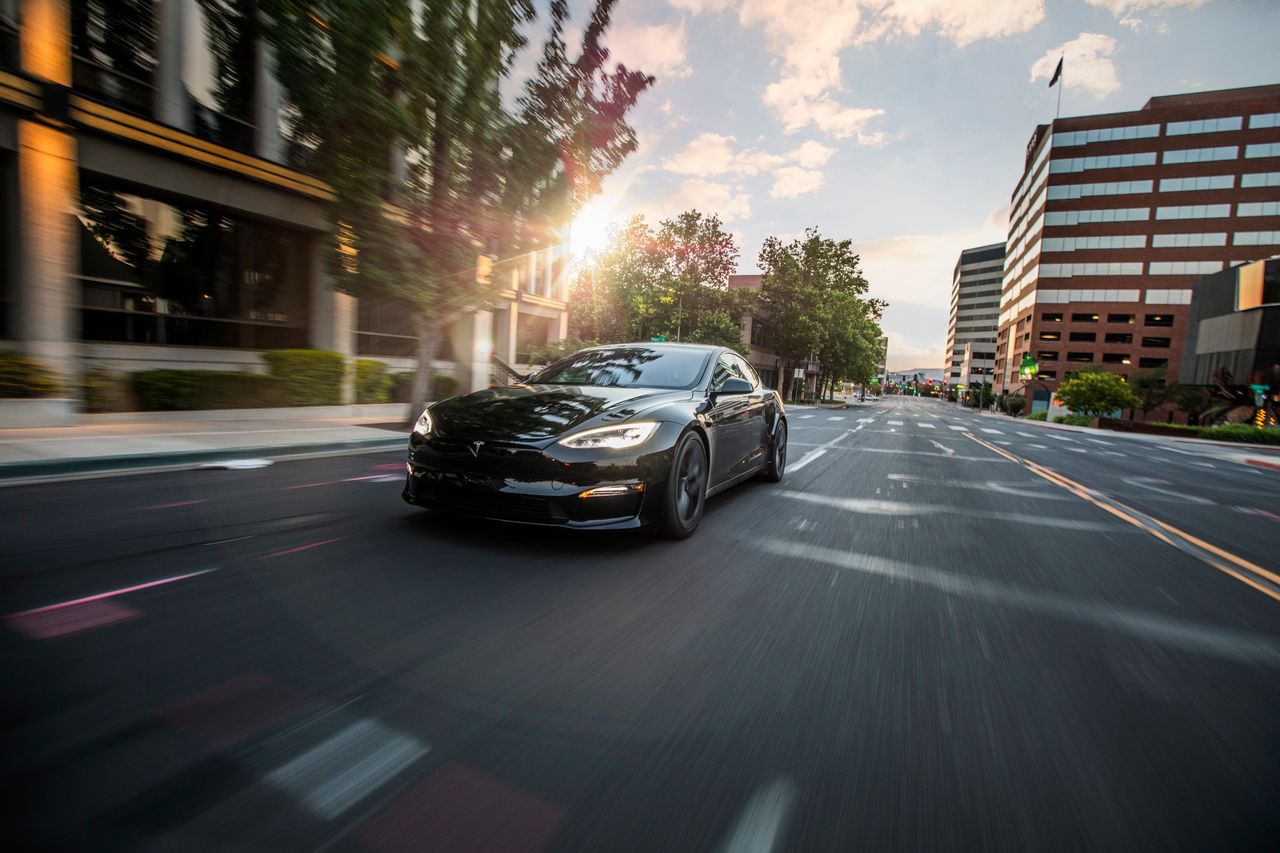Jay Leno on Electric Cars, Hydrogen Fuel, Space Travel—and His Recent Accident
The comedian and car lover has been very happy with the EVs he has bought. He is less interested in leaving Earth, though.
Two years ago, we invited Jay Leno to write about his love of cars, and his thoughts about driving during the pandemic. In that article, he also talked about his fondness for electric cars.
A lot has happened in those two years, with technology companies, auto makers and governments betting a lot of money on electric vehicles as the transportation of the near future. So we thought it was time to check in with Mr. Leno, who is back performing at comedy clubs after his accident in which he suffered severe burns while working on one of his cars. He has new material from the accident, he says.
Here is what Mr. Leno had to say, as told to The Wall Street Journal.
Out with the old, in with the old
They had electric cars before they had gas cars back in the early 1900s. But at the time, what they didn’t have was electricity, at least in homes. I mean wealthy people had it, which is why wealthy Wall Street types bought electric cars for their wives, because they could putt around town and not get on your hands and knees and crank it and get dirty and set the choke and get gasoline on your hands and that kind of thing.
So electric vehicles were always quite popular for that reason. I’ve said this before, but for new technologies to succeed, it can’t be equal. It has to be superior on every level and to other forms.
I’ve got a 1909 Baker Electric and I’ve got a 1914 Detroit Electric that we’ve converted to modern electrics. We put air conditioning and Bluetooth and all kinds of things in the Detroit Electric. My 1909 Baker Electric has not needed any service in the 30 years that I’ve had it. I’ve replaced the batteries because they’re basically like golf-cart batteries, deep cycle six volts. And they last about 12 years. They’re not lithium ion. You could change to lithium ion if you wanted to, but it’s an antique vehicle.
Powering your car and home
I’m quite proud of American manufacturing.
The new electric Ford F-150 is unbelievable. I drove it as a work vehicle. It is eminently practical. You can you go 240 miles on it, and you can power your house for three days with it if you lose power.
When they had the big freeze down there in Houston last year and people had no electricity for days, dealers, in one of the most brilliant public-relations moves, just gave the trucks to people, and people powered their houses for days—making them, if not customers, certainly fans.
Affordable options
I thought a car that was just brilliant was the Chevy Volt. I had one for seven years. It’s a hybrid and you got 40 miles electric free without using any gas. It didn’t seem like much, but I put 90,000 miles on that car, only 3,800 of it was gasoline-powered. I used it at my shop: We’d plug it in, then we’d go to lunch in it, go run an errand and do some chores, which is 25 to 30 miles around Los Angeles. We’d come back, plug it in, and you go back to work for a couple of hours.
I was never having to switch over to the gas part of it. Once a year, every Dec. 7, not for any particular political reason, just every Dec. 7, I’d fill up the tank.
When the Volt stopped that they went to the Bolt, which is pure electric because in a lot of states now you can’t get the tax break or anything with a hybrid.
I think it makes perfect sense that you use your electric car during the week. To sit in traffic on the 405 freeway in bumper to bumper, in something that gets 7 to 9 miles a gallon, really doesn’t make a lot of sense. I used to have a Jaguar; it had a big V-8 engine that was supercharged, and that was $125 a week in gas. And I didn’t feel like I was going anywhere. I switched to the Tesla, and now it costs about the same as a cooking a turkey.
I think the electric car will be the great savior of the classic-car industry and gasoline cars. Remember, in the early 1900s, 500 tons of horse manure were dumped into the streets of New York City every day. Suddenly, the car comes along, and a puff of blue smoke in your face wasn’t so bad. Horses became something people loved, and used for show and racing.
That’s what will happen with the gas car. Sitting in L.A. traffic with a Ferrari going 8 miles an hour is nobody’s idea of fun. So you use an electric car during the week, and on the weekend you drive up in the mountains and use the Ferrari for what it was made for. Or maybe you have a ’65 Mustang. Now it is something to be restored and treasured.
Hydrogen fuel is a sleeper
I love reading future stuff. You look at the year 1900, and they said by the year 1950, women would be sitting in bars, smoking and drinking just like men. It showed women in hoop skirts with one leg in the air and they’re smoking cigarettes and they have a bottle of whiskey in the hand. They never even foresaw women having voting rights, women becoming senators, women having equality with men. They only saw it as they would pick up the bad habits of men.
Nobody ever thinks that far ahead.
Everybody predicted flying cars. But that never happened.
Nobody predicted when I was a kid that we’d be carrying a phone. When I was in the fifth grade, a guy from a Bell phone company came to our classroom, and he said by the time we were grown up, no American would be further than one mile from a phone, no matter where they were in the United States. And we just thought that was unbelievable. The idea of carrying a phone with you never ever occurred to anybody. A Star Trek communicator? That was hundreds of years in the future. But it has happened already.
The other great one for cars is hydrogen. Hydrogen can be a real player in the future and I would not rule it out.
I like hydrogen because the more alternatives you have, the better. During World War II, when there was a gasoline shortage, a lot of people pulled out their old Stanley Steamer cars. And people converted their cars. There used to be a thing called a gasifier. They would put it so it looks like a big stove in the back seat of the car and they would burn wood or coal, they would run a tube to the carburetor and the car would run on the methane from the burning of the wood or coal just like with gas. It was inconvenient, yes. It was messy, it was dirty, but it did provide transportation when gasoline was not available.
In case of some sort of natural disaster where, oh, our lines of fuel are shut off, we have electricity, we have hydrogen, we even have steam if necessary.
I demonstrated a hydrogen car back onstage in 2001. I said, “Give me a glass.” So I took a glass and I started up the hydrogen car on the stage, and I put the glass under the tailpipe and I went back to the talk. The byproduct of hydrogen is water. After 20 minutes, the glass filled up with water, and I drank it and people were astounded. It wasn’t the best-tasting water, but there was nothing harmful about it. Hydrogen is a viable fuel because the only byproduct is water. I think hydrogen is a sleeper.
Bullish on Tesla
Last year, I sold my old Tesla and bought a new one, the Tesla Plaid. That’s the latest version, and at least as of this date, it’s the fastest-accelerating car you could buy with the exception of the $2.5 million Rimac. If you’re looking for performance at a reasonable price, it’s a pretty good deal. My other Tesla was seven years old. I got $95,000 for it. It held its value. The battery dropped maybe 3% to 5%. As a first-generation Tesla, you got about 228 miles on a charge. When I sold it, it was 223, maybe. I never went to the Tesla shop for anything other than a flat tire.
Space travel
I realized I am not an out-of-the-box thinker. I remember talking to Elon Musk years ago about his high-speed train. And I asked, “You’re building this high-speed train to go like 200 mph.” He said, “Oh no, 800.” How can it be? He told me something like 800 mph, because it’s not a train, it’s a vacuum tube. And I realized he’s thinking on a level I’m not.
I have no interest in going into space. I see why he’s fascinated with it. But there’s nothing there. Imagine, you’re now on Mars. Todd? Susan? Anybody here? I don’t get it. I have no desire to perform in an empty auditorium. I gravitate toward cities. I don’t go to a mountain for three weeks by myself.
The recent accident
Eight days later, I had a brand new face. And it’s better than what was there before.
But really, it was an accident, that’s all. Anybody who works with their hands on a regular basis is going to have an accident at some point. If you play football, you get a concussion or a broken leg. Anything you do, there’s a risk factor.
You have to joke about it. There’s nothing worse than whiny celebrities. If you joke about it, people laugh along with you.
 Copyright 2020, Dow Jones & Company, Inc. All Rights Reserved Worldwide. LEARN MORE
Copyright 2020, Dow Jones & Company, Inc. All Rights Reserved Worldwide. LEARN MORE
This stylish family home combines a classic palette and finishes with a flexible floorplan
Just 55 minutes from Sydney, make this your creative getaway located in the majestic Hawkesbury region.
As Paris makes its final preparations for the Olympic games, its residents are busy with their own—packing their suitcases, confirming their reservations, and getting out of town.
Worried about the hordes of crowds and overall chaos the Olympics could bring, Parisians are fleeing the city in droves and inundating resort cities around the country. Hotels and holiday rentals in some of France’s most popular vacation destinations—from the French Riviera in the south to the beaches of Normandy in the north—say they are expecting massive crowds this year in advance of the Olympics. The games will run from July 26-Aug. 1.
“It’s already a major holiday season for us, and beyond that, we have the Olympics,” says Stéphane Personeni, general manager of the Lily of the Valley hotel in Saint Tropez. “People began booking early this year.”
Personeni’s hotel typically has no issues filling its rooms each summer—by May of each year, the luxury hotel typically finds itself completely booked out for the months of July and August. But this year, the 53-room hotel began filling up for summer reservations in February.
“We told our regular guests that everything—hotels, apartments, villas—are going to be hard to find this summer,” Personeni says. His neighbours around Saint Tropez say they’re similarly booked up.
As of March, the online marketplace Gens de Confiance (“Trusted People”), saw a 50% increase in reservations from Parisians seeking vacation rentals outside the capital during the Olympics.
Already, August is a popular vacation time for the French. With a minimum of five weeks of vacation mandated by law, many decide to take the entire month off, renting out villas in beachside destinations for longer periods.
But beyond the typical August travel, the Olympics are having a real impact, says Bertille Marchal, a spokesperson for Gens de Confiance.
“We’ve seen nearly three times more reservations for the dates of the Olympics than the following two weeks,” Marchal says. “The increase is definitely linked to the Olympic Games.”

Getty Images
According to the site, the most sought-out vacation destinations are Morbihan and Loire-Atlantique, a seaside region in the northwest; le Var, a coastal area within the southeast of France along the Côte d’Azur; and the island of Corsica in the Mediterranean.
Meanwhile, the Olympics haven’t necessarily been a boon to foreign tourism in the country. Many tourists who might have otherwise come to France are avoiding it this year in favour of other European capitals. In Paris, demand for stays at high-end hotels has collapsed, with bookings down 50% in July compared to last year, according to UMIH Prestige, which represents hotels charging at least €800 ($865) a night for rooms.
Earlier this year, high-end restaurants and concierges said the Olympics might even be an opportunity to score a hard-get-seat at the city’s fine dining.
In the Occitanie region in southwest France, the overall number of reservations this summer hasn’t changed much from last year, says Vincent Gare, president of the regional tourism committee there.
“But looking further at the numbers, we do see an increase in the clientele coming from the Paris region,” Gare told Le Figaro, noting that the increase in reservations has fallen directly on the dates of the Olympic games.
Michel Barré, a retiree living in Paris’s Le Marais neighbourhood, is one of those opting for the beach rather than the opening ceremony. In January, he booked a stay in Normandy for two weeks.
“Even though it’s a major European capital, Paris is still a small city—it’s a massive effort to host all of these events,” Barré says. “The Olympics are going to be a mess.”
More than anything, he just wants some calm after an event-filled summer in Paris, which just before the Olympics experienced the drama of a snap election called by Macron.
“It’s been a hectic summer here,” he says.

AFP via Getty Images
Parisians—Barré included—feel that the city, by over-catering to its tourists, is driving out many residents.
Parts of the Seine—usually one of the most popular summertime hangout spots —have been closed off for weeks as the city installs bleachers and Olympics signage. In certain neighbourhoods, residents will need to scan a QR code with police to access their own apartments. And from the Olympics to Sept. 8, Paris is nearly doubling the price of transit tickets from €2.15 to €4 per ride.
The city’s clear willingness to capitalise on its tourists has motivated some residents to do the same. In March, the number of active Airbnb listings in Paris reached an all-time high as hosts rushed to list their apartments. Listings grew 40% from the same time last year, according to the company.
With their regular clients taking off, Parisian restaurants and merchants are complaining that business is down.
“Are there any Parisians left in Paris?” Alaine Fontaine, president of the restaurant industry association, told the radio station Franceinfo on Sunday. “For the last three weeks, there haven’t been any here.”
Still, for all the talk of those leaving, there are plenty who have decided to stick around.
Jay Swanson, an American expat and YouTuber, can’t imagine leaving during the Olympics—he secured his tickets to see ping pong and volleyball last year. He’s also less concerned about the crowds and road closures than others, having just put together a series of videos explaining how to navigate Paris during the games.
“It’s been 100 years since the Games came to Paris; when else will we get a chance to host the world like this?” Swanson says. “So many Parisians are leaving and tourism is down, so not only will it be quiet but the only people left will be here for a party.”
This stylish family home combines a classic palette and finishes with a flexible floorplan
Just 55 minutes from Sydney, make this your creative getaway located in the majestic Hawkesbury region.























